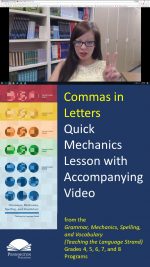Commas in Letters
Commas in Letters
Play the quick video lesson HERE and click the upper left back arrow to return to this lesson.
Common Core Language Standard 2
Teachers teach students two forms of letters: the friendly letter and the business letter. Each has its own special greetings and closings. A friendly letter is personal and informal. A business letter may be personal or impersonal; however, it certainly is formal.
Today’s mechanics lesson is on commas in letter greetings and closings. Remember that there are two basic kinds of letters: friendly and business.
Now let’s read the grammar and usage lesson and study the examples.
Place a comma after the greeting and after the closing in a friendly letter. Examples: Dear Mom, and Love, Place a colon after the greeting and a comma after the closing in a business letter.
Examples: To Whom It May Concern: and Sincerely,
Now circle or highlight what is right and revise what is wrong according to grammar and usage lesson.
Practice: He signed his business letter “Sincerely,” and his friendly letter “Yours truly,”. His business letter greeting was “To Whom It May Concern:” and his friendly letter was just “Hello”.
Let’s check the Practice Answers.
Grammar and Usage Practice Answers: He signed his business letter “Sincerely,” and his friendly letter “Yours truly,”. His business letter greeting was “To Whom It May Concern:” and his friendly letter was just “Hello,”.
Now let’s apply what we have learned.
Writing Application: Write your own short business letter.
*****

Pennington Publishing Grammar Programs
Teaching Grammar, Usage, and Mechanics (Grades 4, 5, 6, 7, 8, and High School) are full-year, traditional, grade-level grammar, usage, and mechanics programs with plenty of remedial practice to help students catch up while they keep up with grade-level standards. Twice-per-week, 30-minute, no prep lessons in print or interactive Google slides with a fun secret agent theme. Simple sentence diagrams, mentor texts, video lessons, sentence dictations. Plenty of practice in the writing context. Includes biweekly tests and a final exam.
Grammar, Usage, and Mechanics Interactive Notebook (Grades 4‒8) is a full-year, no prep interactive notebook without all the mess. Twice-per-week, 30-minute, no prep grammar, usage, and mechanics lessons, formatted in Cornell Notes with cartoon response, writing application, 3D graphic organizers (easy cut and paste foldables), and great resource links. No need to create a teacher INB for student make-up work—it’s done for you! Plus, get remedial worksheets, biweekly tests, and a final exam.
Syntax in Reading and Writing is a function-based, sentence-level syntax program, designed to build reading comprehension and increase writing sophistication. The 18 parts of speech, phrases, and clauses lessons are each leveled from basic (elementary) to advanced (middle and high school) and feature 5 lesson components (10–15 minutes each): 1. Learn It! 2. Identify It! 3. Explain It! (analysis of challenging sentences) 4. Revise It! (kernel sentences, sentence expansion, syntactic manipulation) 5. Create It! (Short writing application with the syntactic focus in different genre).
Get the Diagnostic Grammar, Usage, and Mechanics Assessments, Matrix, and Final Exam FREE Resource:
![]()
